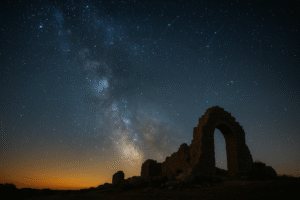Have you ever wondered what happened right after the Big Bang? The Universe didn’t just expand slowly over time; it underwent a period of rapid, exponential expansion called cosmic inflation. This event, which took place within the first fraction of a second after the Big Bang, played a crucial role in shaping the Universe as we know it today. In this blog, we’ll dive into the science of cosmic inflation, unravelling the mysteries of the early Universe in a way that’s easy to understand and engaging.
What Exactly is Cosmic Inflation?
Cosmic inflation is the theory that proposes the Universe expanded exponentially in its first moments of existence. Picture a balloon: as you blow it up, it gets bigger and bigger. Now imagine that balloon inflating in the blink of an eye—this gives you an idea of the speed and scale of inflation. This period of rapid expansion solved several puzzles that early astronomers and physicists faced, such as why the Universe looks relatively uniform and why it is so large.
The idea of cosmic inflation was first introduced by physicist Alan Guth in 1980. His work provided a solution to the so-called “flatness problem” and the “horizon problem” (more on those in a bit!). Guth proposed that a sudden burst of inflation stretched out any initial curvature in the Universe, making it appear flat and smoothing out temperature differences.

The Flatness Problem
One of the key questions cosmic inflation addresses is the flatness problem. The Universe seems to be geometrically flat on a large scale, meaning parallel lines never meet, and the angles of a triangle add up to 180 degrees. However, according to Einstein’s general theory of relativity, this shouldn’t necessarily be the case. Without inflation, the Universe could have curved dramatically over time, leading to either a closed or open geometry.
Cosmic inflation solved this by expanding the Universe so quickly that any curvature became imperceptible, much like how the surface of a balloon seems flat when it’s fully inflated. Imagine being on a small patch of Earth—it looks flat to you even though you know it’s round. Inflation makes the Universe look flat in a similar way.
The Horizon Problem
Another mystery is the horizon problem. When we observe the Universe, distant regions appear to have the same temperature and properties, even though they are so far apart that light (or any information) couldn’t have travelled between them since the Big Bang. This suggests they were somehow “connected” in the past.
Cosmic inflation explains this by proposing that these distant regions were once much closer together before inflation stretched them apart. They had time to “exchange information” and equalize their properties before the Universe expanded. This way, distant regions of the Universe could share the same characteristics, solving the horizon problem.
Quantum Fluctuations: The Seeds of Galaxies
Cosmic inflation didn’t just smooth things out—it also created the seeds for the galaxies we see today. During inflation, tiny quantum fluctuations in the fabric of space-time were stretched out. These fluctuations acted as the foundation upon which matter would eventually clump together, forming stars, galaxies, and entire clusters. Without cosmic inflation, the Universe might not have had the structure we observe today.
A great analogy would be baking bread. Imagine the dough as the Universe. The tiny pockets of air in the dough are like the quantum fluctuations. As the dough rises (inflates), these air pockets become the areas where galaxies will eventually form.
The Role of the Inflaton Field
The inflationary period was driven by a hypothetical field known as the inflaton field. This field had a high energy level, which caused space to expand at an exponential rate. As the Universe inflated, the energy in the inflaton field gradually dissipated, leading to the end of inflation. The remaining energy was then converted into particles, kickstarting the Universe’s next phase of slower expansion.
Although we don’t yet fully understand the inflaton field or whether it exists, the theory aligns with many observable facts about the Universe.
Case Study: The Cosmic Microwave Background
One of the most compelling pieces of evidence for cosmic inflation comes from the Cosmic Microwave Background (CMB), which is the afterglow of the Big Bang—a faint radiation that permeates the universe. It was first discovered in 1965 by Arno Penzias and Robert Wilson, and its near-uniform temperature is one of the triumphs of the inflationary theory.
Scientists have studied the tiny fluctuations in the CMB using satellites like the WMAP (Wilkinson Microwave Anisotropy Probe) and Planck. These fluctuations align with the predictions of cosmic inflation, providing strong support for the theory.
Are There Other Theories?
While cosmic inflation is the leading explanation for the Universe’s early rapid expansion, it isn’t the only theory. Alternative theories, such as the cyclic universe model, propose that the universe undergoes repeated cycles of expansion and contraction. Others propose variations of inflation that involve different mechanisms or outcomes. However, none of these models have the same level of observational support as cosmic inflation.
The Ongoing Mysteries
While cosmic inflation explains many aspects of the early Universe, it’s not without its mysteries. For one, the exact mechanism behind inflation is still unknown. Physicists are still hunting for evidence of the inflaton field or other forces that may have caused inflation. Moreover, inflation predicts that the Universe will continue expanding forever, raising questions about the ultimate fate of the cosmos.
Conclusion:
Cosmic inflation offers a fascinating glimpse into the very first moments of the Universe, explaining how our vast cosmos could emerge from something so small. From solving age-old problems like the flatness and horizon issues to providing the foundation for the formation of galaxies, inflation has become a cornerstone of modern cosmology. Yet, many questions remain. As physicists continue to study the Universe, we may one day understand the full story of cosmic inflation and the forces that shaped our world.
Author’s Note:
As we explore these vast and complex topics, I hope this blog has made cosmic inflation a bit more accessible and intriguing. The wonders of the Universe are all around us, and each discovery brings us closer to understanding our place in it.
G.C., Ecosociosphere contributor.
References and Further Reading:
- NASA: Cosmic Inflation Theory
- The Inflationary Universe by Alan Guth
- New, A. (2012). The Cosmological Origin of Primordial Magnetic Fields. https://core.ac.uk/download/235566130.pdf
- Which came first – black holes or galaxies? – The Brighter Side of News. https://www.thebrighterside.news/post/which-came-first-black-holes-or-galaxies
- Stewart, I. (2008). It’s a wrap. New Scientist. https://doi.org/10.1016/s0262-4079(08)63242-x
- How Did The Universe Begin? – Alien Cosmos. https://aliencosmos.com/how-did-the-universe-begin/





Comments
Fantastic beat I would like to apprentice while you amend your web site how could i subscribe for a blog site The account helped me a acceptable deal I had been a little bit acquainted of this your broadcast offered bright clear concept
Mat6tube I’m unsure how I ended up here, but I felt this publish was really good